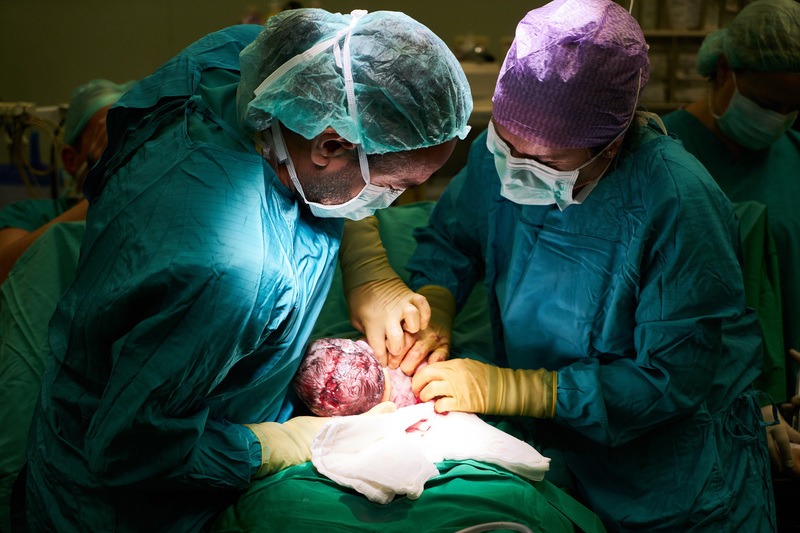C-section risk 50 times higher for mothers in Africa
20 March 2019 | Story Provided. Photo Engin Akyurt, Pixabay. Read time 5 min.
The maternal mortality rate following a C-section (caesarean section) in Africa may be 50 times higher than that in high-income countries, according to an observational study of more than 3 500 mothers from 22 African countries, published in The Lancet Global Health.
The study, led by Professor Bruce M Biccard, Second Professor and Second Chair in the Department of Anaesthesia and Perioperative Medicine at the University of Cape Town (UCT), found the rate of maternal deaths appears to be substantially higher than expected at 5.43 per 1 000 operations compared to 0.1 per 1 000 operations in the United Kingdom.
One in six women developed complications during surgery – nearly three times that of women in the USA. Intraoperative and postoperative bleeding was the most common complication for women in Africa, and occurred in 3.8% of mothers.
“Improvement of C-section surgical outcomes could substantially improve both maternal and neonatal mortality, which would lead to key global health gains.”
Funded by the South African Medical Research Council (SAMRC), the study forms part of the African Surgical Outcomes Study (ASOS). It measured the surgical outcomes of all patients who received surgery during a seven-day period in 247 hospitals across 25 countries in Africa.
“Improvement of C-section surgical outcomes could substantially improve both maternal and neonatal mortality, which would lead to key global health gains,” says Professor Biccard.
The findings highlight the urgent need for improved safety of the procedure. Mothers who had preoperative placental complications, ruptured uterus, bleeding before birth, severe obstetric bleeding during surgery, and anaesthesia complications, were more likely to die after C-section.
The scarcity of specialist care available was highlighted, showing an average of 0.7 specialists per 100 000 population. Hospitals surveyed had an average of three specialist obstetricians, three specialist surgeons and two specialist anaesthesiologists. Almost one in four women received anaesthesia from a non-specialist, and since 10% of the deaths recorded happened after anaesthesia complications, the study highlights the need for safer anaesthesia for women during caesarean delivery.
The study also found that the neonatal mortality rate (deaths in the first 28 days of life) after C-section in Africa was double the global average. The global average for all deliveries in 2016 was 19 per 1 000 deliveries, while the rate recorded in the study was 44 per 1 000 births (based on 153 deaths out of 3 506 livebirths).
“Substantial progress has been made over the past 20 years in reducing maternal mortality, including in Africa, yet global disparities persist across all levels of obstetric care… As the present study highlights, making childbirth safer for African mothers will require dedicated efforts to make caesarean section much safer as well,” writes Dr Anna J Dare of the University of Toronto in The Lancet Global Health.
These figures may in fact be conservative, as the study included fewer than half of the countries in Africa and two thirds of the study population were from middle-income countries, whilst several of the continent’s poorest countries were not included. Also, a disproportionate number of regional or tertiary hospitals, compared with district hospitals, were included in the study. Data from the South African Confidential Enquiries into Maternal Deaths suggests that deaths are higher in district hospitals.
Eleven of the countries (Democratic Republic of Congo, The Gambia, Madagascar, Mali, Mauritius, Namibia, Niger, Nigeria, South Africa, Uganda, and Zimbabwe) provided data on more than 90% of the surgeries.
“The strength of our work is that we have done a large, prospective study across Africa. This study suggests that the incidence of both maternal and neonatal complications in Africa is substantially higher than previously appreciated. Furthermore, these data have enabled us to identify risk factors independently associated with maternal mortality, which include preoperative risk factors for obstetric haemorrhage and the perioperative complications of peripartum haemorrhage and anaesthesia complications. Attention should therefore be focused on these areas to improve maternal and neonatal outcomes in Africa,” concludes the study teams’ report.
The full report is available from The Lancet Global Health.
 This work is licensed under a Creative Commons Attribution-NoDerivatives 4.0 International License.
This work is licensed under a Creative Commons Attribution-NoDerivatives 4.0 International License.
Please view the republishing articles page for more information.










